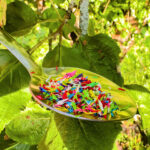by: October 2, 2024
 (NaturalHealth365) Take out your wallet and grab the first credit card you see. Now prepare yourself for a surprising reality check: on average, you consume this amount of microplastics – every week!
(NaturalHealth365) Take out your wallet and grab the first credit card you see. Now prepare yourself for a surprising reality check: on average, you consume this amount of microplastics – every week!
Wondering how it’s possible to eat plastic without knowing it? It may be helpful to realize that there are microplastics in fish, sea salt, water, and many other things we use and consume daily as typical Americans.
If you want to protect yourself and your loved ones against these widespread environmental pollutants, then it’s time to educate yourself about this plastic problem.
You and your loved ones consume tens of thousands of microplastics (yearly) – here’s how it affects your health
The daily and regular use of plastics can be found in nearly every industry, from cosmetics and food packaging to electronics and toys. Because they are so widespread, these small plastic particles can easily leach into your food and water. They also can be emitted into the air, which means you’re breathing in thousands of toxic plastic particles every year, too.
As we’ve reported before, these microplastics can negatively impact human health in various ways (and we won’t even get into the effects of plastic on the planet). Specifically, research has shown that plastics in the body can:
- Disrupt hormones
- Act as carcinogens
- Harm reproductive health
- Contribute to hearing loss
- Contribute to obesity
- Weaken the immune system
- Damage organs
- Contribute to developmental delays in children
Many plastics contain known toxins such as bisphenol A (BPA), styrene, and phthalates. Official organizations such as the American Chemistry Council and the American Academy of Pediatrics call for these chemicals to be more closely regulated, but they remain widespread today.
As a health-conscious consumer, you may find it hard not to feel disheartened.
These 5 tips will help you reduce your exposure to toxic plastics in food and water
Since the 1950s, humans have produced a whopping 8 billion tons of plastic, with only 10% of that having ever been recycled. There’s no doubt that microplastics are everywhere, and it may not be feasible to reduce your exposure to true nil.
But there are a few things you can do to minimize your accidental consumption though:
- Drink from a water source that’s been put through a high-quality water purification system. Most bottled water contains twice the amount of microplastics. No doubt, water filtration is essential for removing harmful fluoride and other chemicals found in most municipal water supplies.
- Don’t heat your food in plastic containers – instead, use glass containers or simmer on the stove in high-quality cookware (such as a cast iron skillet or ceramic pot).
- Eat more fresh foods. These are less likely to contain high levels of microplastics – especially if purchased locally from organic growers.
- Re-think your dependency on plastic, especially single-use items like bags and plastic wrap. Remember, the vast majority of plastic is never recycled anyway. If you do purchase plastic items, avoid ones with recycling codes “3,” “6,” and “7” since these indicate the presence of phthalates, styrene, and bisphenols (respectively).
- Avoiding sea salt contaminated with microplastics.
Whether it’s switching to a reusable bottle or swapping plastic containers for glass, these simple choices can have a big impact. You can’t avoid all the plastic in the world, but you can certainly tip the scales in your favor.
Sources for this article include:
No hay comentarios:
Publicar un comentario